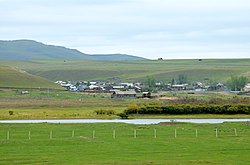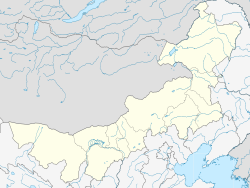Ergun City: Difference between revisions
russian descendants in villages and towns |
|||
| Line 157: | Line 157: | ||
* Others ([[Hui people|Hui]] etc.) 10,809 |
* Others ([[Hui people|Hui]] etc.) 10,809 |
||
Along the towns and villages of the Argun River within the boundaries of Ergun City are thousands of descendants of |
Along the towns and villages of the Argun River within the boundaries of Ergun City are thousands of descendants of intermarriages between [[Han Chinese]] men and [[Russian]] women.<ref name="mixedmarriages">{{cite book |title=Entangled Histories: The Transcultural Past of Northeast China |date=2014 |publisher=Springer |location=London |pages=47-58 |url=https://www.asia-europe.uni-heidelberg.de/fileadmin/Pictures/Publications/springer_books/Ben-Canaan_and_Gruener_Springer_The_Transcultural_Past_of_Northeast_China.pdf}}</ref> This Russian descended population forms a large portion of the total number of [[Russians in China]]. One of the townships is Enhe, which is the only one of the settlements to be an official ethnic Russian township.<ref name="mixedmarriages"/> |
||
There are two international border crossings in the county-level city at [[Shiwei, Inner Mongolia|Shiwei]] and [[Heishantou]].<ref name=eegn/> |
There are two international border crossings in the county-level city at [[Shiwei, Inner Mongolia|Shiwei]] and [[Heishantou]].<ref name=eegn/> |
||
Revision as of 05:59, 13 October 2019
Ergun
额尔古纳市 • ᠡᠷᠬᠥᠨᠠᠬᠣᠲᠠ | |
|---|---|
 Village on the Argun River | |
 Ergun in Hulunbuir | |
| Coordinates: 50°14′35″N 120°10′52″E / 50.243°N 120.181°E | |
| Country | People's Republic of China |
| Autonomous region | Inner Mongolia |
| Prefecture-level city | Hulunbuir |
| Area | |
| • Total | 28,400 km2 (11,000 sq mi) |
| Population | |
| • Total | 85,162 |
| • Density | 3.0/km2 (7.8/sq mi) |
| Time zone | UTC+8 (China Standard) |
| Postal code | 022050 |
| Area code | 0470 |
| Website | http://www.eegn.gov.cn/ |
Ergun (simplified Chinese: 额尔古纳市; traditional Chinese: 額爾古納市; pinyin: É'ěrgǔnà-shì; Mongolian: Эргүн Ergün), formerly Ergun Right Banner (Mongolian: ᠡᠷᠬᠥᠨᠠ ᠬᠣᠲᠠ Эргүнэ хот; Chinese: 额尔古纳右旗; pinyin: E'erguna You Qi), is a county-level city in Hulunbuir, Inner Mongolia, containing the autonomous region's northernmost point.
The county-level city had the population of 85,162 people as of 2006.[1]
Geography
Administratively, Ergun is part of the prefecture-level city of Hulunbuir. It occupies 28,400 km2 (11,000 sq mi) the right (south-eastern) bank of the Argun River, which forms China's border with Russia's Zabaykalsky Krai (formerly, Chita Oblast).[2]
Subdivisions

The county-level city of Ergun is divided into 2 subdistricts (街道办事处), 3 towns, 2 ethnic townships, one township and one sum.[1] As of 2006, their population was reported as follows:
- Labudalin Subdistrict (拉布大林街道), 35,994 - seat of the city government.[3]
- Shangkuli Subdistrict (上库力街道), 7,032
- Moridaga (Mo'erdaoga) Town (莫尔道嘎镇), 25,309
- Heishantou Town (黑山头镇), 1,797
- Enhe Hada Town (恩和哈达镇)
- Sanhe Hui Ethnic Township (三河回族乡), 11,497
- Shiwei (室韦)
- Enhe (恩和)
- Jiqian Township (奇乾乡)
- Mengwu Shiwei Sum (蒙兀室韦苏木)
Demographics
Ethnic composition of the county-level city of Ergun, as of 2006, was reported as follows:[1]
Along the towns and villages of the Argun River within the boundaries of Ergun City are thousands of descendants of intermarriages between Han Chinese men and Russian women.[4] This Russian descended population forms a large portion of the total number of Russians in China. One of the townships is Enhe, which is the only one of the settlements to be an official ethnic Russian township.[4]
There are two international border crossings in the county-level city at Shiwei and Heishantou.[2]
Ergun Wetlands
The city's claim to fame is the Ergun Wetlands (formerly known as the Genhe Wetlands), a plain delta formed by the Argun River and the Genhe River, Deerbugan River and Hawuer River. The Ergun Wetlands is one of the largest wetlands in Asia, lying about 3km to the west of Labudalin Subdistrict, the urban area and seat of government, of the county-level city.
The wetlands are very lush in the middle of summer and see "oil painting like" autumn hues of red and yellow in September, attracting tourists and photographers for the scenery and wildlife.[5] After the end of September the wetlands wither and turn dark.[6] A panoramic view of the wetlands is afforded from a tourist scenic view overlooking the area from a hill 720 meters above sea level.[7]
The encroachment of urban development has made preservation of the wetland difficult but were bolstered by a wetland protection law in 2012.[8]
References
- ^ a b c 额尔古纳市概况 [Description of Ergun City]. Hulunbuir People's Government (in Simplified Chinese).[permanent dead link]
- ^ a b "Archived copy" 市情概述 (in Simplified Chinese). Archived from the original on 2012-11-28. Retrieved 2009-10-07.
{{cite web}}: CS1 maint: archived copy as title (link) - ^ "Archived copy" 额尔古纳市拉布大林街道办事处 (in Simplified Chinese). Archived from the original on 2011-07-10. Retrieved 2009-10-07.
{{cite web}}: CS1 maint: archived copy as title (link) - ^ a b Entangled Histories: The Transcultural Past of Northeast China (PDF). London: Springer. 2014. pp. 47–58.
- ^ "Autumn scenery gives N China wetland picturesque view". CGTN. September 20, 2019.
- ^ Wang, Kaihao (October 17, 2013). "River valley produces wetlands wonder". China Daily.
- ^ "Ergun wetland in Inner Mongolia, one of the largest in Asia". ecns.com. November 11, 2013.
- ^ Wang, Qian; Zheng, Jinran (May 14, 2012). "Ergun wetland threatened by development, urbanization". China Daily.

